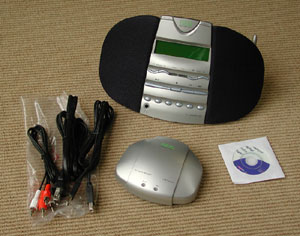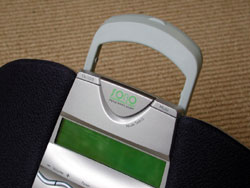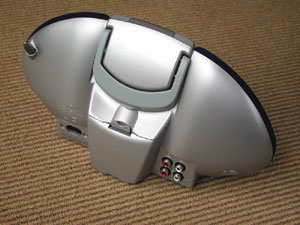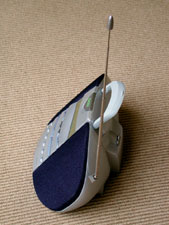|
|
|
|
|
Merconnet SONOWave Digital Media Player |
|
Join the community - in the OCAU Forums!
|
Merconnet sent over a sample of their Sono Digital Media Player for review. You might remember Merconnet as the Canadian company that provided us with the Digiana AudiaX, which let you send signals from your iPod or similar, so that your FM radio could pick them up. This new device takes that idea a step further, by actually being a radio that can receive MP3, streamed or other audio from your PC.
 
Inside the fairly unexciting box we received the radio itself, a bundle of cables, a USB transceiver and an 8cm CD with drivers and PDF manual. Note that no printed manual is included, not even a quickstart sheet. The bundled cables are 2x RCA for connecting to other audio devices, a non-Australian power cord and a standard USB cable.
Receiving a non-Australian power cord isn't too unusual - Merconnet are after all a Canadian company who sent the product to us direct from Canada. However it's always a good idea to check the voltage for international devices - and in this case the Sono player is 110v only. Uh-oh! For non-Australian readers, we (like much of the world) use 240v mains power, so plugging the Sono into the wall would be a bad idea. Fortunately the Sono can be run from batteries (not included), so after rustling up eight C-cells we were good to go. The only features that can't be used on battery power are related to the clock (time display, alarm clock etc), so no great loss there. In fact, the website indicates that a universal power supply is included, so perhaps future units will be more internationally compatible.
The concept behind this device is fairly simple. A USB transceiver plugs into your PC and talks to the radio up to 300 feet (~100M) away. The provided software allows you to either pipe ALL sound from your PC out to the remote radio, or only specific kinds of audio. It's particularly useful for streaming internet radio, and makes it a bit more user-friendly to access your favourite net radio station around the house, rather than than clicking URLs on your PC. With 6 preset buttons you can choose between your favourite stations easily.
 
The controls are all on the front panel of the radio. Across the bottom you have the six preset buttons, above that are buttons to Play, Pause, Stop, as well as Fwd/Rew navigation. Above those are volume buttons, power and data indicators, as well as Tune buttons for the FM radio mode. The green LCD screen above that shows a range of info and is matched by the screen in the software shown below. There's a fairly plasticky fold-out handle for taking your tunes on the road, as well as slightly fiddly top-mounted On/Off and Mute buttons. The central button (marked "Sono") is for changing between the various modes, to which correspond to modes in the software ("Radio", "MP3", "CD" etc) and let it function as a normal FM radio.
 
On the back of the unit there's a standard radio-cord power socket and four RCA jacks. Using these you can connect the SONOWave to your hifi (or VCR etc) for audio input or output. So you could use these to get internet streamed radio to your wizz-bang HiFi at home. There's also an extendable antenna for talking to the USB transceiver on your PC - which has no external antenna itself.
The SONOWave is quite clearly the same as a BT Voyager DMP, incidentally. Although the box and the unit itself are branded as Merconnet, all the software (even the desktop icon) carries the BT Voyager name. That's no bad thing, with the BT Voyager having a pretty good reputation based on a quick Google.
Installation:
Installation is fairly easy. You simply connect the USB transceiver and install the software from the CD. Windows installs a couple of USB devices, and you do need to have Windows Media Player 9, so that will be installed from the CD if you don't have it. It's worth noting that the Sono's software doesn't try to automatically associate itself with every type of media file in the universe (unlike WMP9).
Speaking of the software:

It's quite intuitive and easy to use. I've set up the radio presets with 6 streams from Internode's radio mirror service, because as an ADSL customer of theirs the streaming radio doesn't count against my quota. I tested a few other external services and they worked fine too. It's worth noting that the full URLs on Internode's page don't work if you include the .pls file, but if you simply specify the server and port they work fine.
There are some definite quirks to the software, though - mostly to do with getting the sound to actually come out of the radio, instead of your PC. When first installed, all my system sounds (but no music) came from the radio, which seemed very odd. The manual notes that you have to change the default audio device on your PC back to whatever it should be (in my case, nForce Audio) from "DMP", because it will have the wrong default after installation. Fair enough. So now we have system sounds coming from the PC.. and streamed music coming from the PC. You can change channels on the radio, but the actual sound comes from the PC's speakers. Digging around in the manual reveals that you need to set the correct device in the BT Voyager software (left-click the top-left icon, choose Options, select "DMP" as the target device). Ok! But still, sound comes from the PC, not the radio. Even more manual digging finds that (in a totally unrelated part of the manual) you have to RIGHT-click the top-left icon so it turns from a speaker picture into a picture of the DMP. Then it works! We now have system sounds coming from the PC speaker but music played/selected via the Voyager software coming from the radio unit.
Usage:
Once installed, the radio works as you'd expect. Whatever you choose via the Voyager software or the front-panel controls emerges from the speakers. You can actually use any software you like, as long as it lets you choose the output device. In Winamp for example you configure the output plugin to send to device "DMP". Stop then restart playing, and the sound comes out from the remote radio.
The speakers in the radio unit are about as good as you'd expect, which is to say, not fantastic. At full volume the unit is too loud to have sitting on the desk next to you, and distorts at both extremes of treble and bass. At about 3/4 volume the sound is a lot clearer, although there's a faint hiss during the silent parts, and you could comfortably listen at this level in a normal-sized livingroom. If you want to fill the house with massive noise, you'll need to use the RCA outputs to connect to your HiFi. Hooked up to the stereo in our lounge the unit sounded great to my non-audiophile ears, as good as a CD.
Range and Battery Life:
Merconnet/BT claim "300 feet" for the range, which is about 100M. With the USB transceiver sitting on top of the full-tower case on my desk, I can listen fine at the other end of the house, which I've previously worked out to be about 22M away, with 4 walls inbetween. However at that range I can't change channels etc - it seems the player can't talk to the PC, but can receive the streamed signal ok. It works fine a couple of rooms away, or in the backyard.
Merconnec claim 30h of continuous listening at medium volume from a set of batteries. Even considering the cost of 8x C cells, that's ok, assuming you only use it for a couple of hours at a time. For lots of use you'd be best off figuring out to run an extension cord to it, or investing in some rechargeables and a charger.
Conclusions:
This is quite a neat gadget that performs as advertised. If you're a fan of internet radio or your MP3 collection, but want a little more flexibility with listening to it around the house, the Merconnet SONOWave Digital Media Player could be for you. I'm not aware of an Australian distributor yet, but Merconnet list it for $149.99 USD on their website.
|
|
Advertisement:
All original content copyright James Rolfe.
All rights reserved. No reproduction allowed without written permission.
Interested in advertising on OCAU? Contact us for info.
|

|


